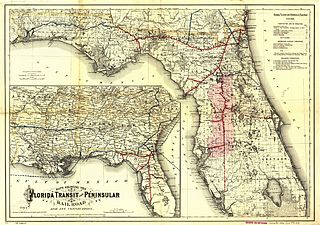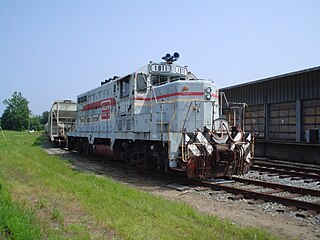
The Norfolk Southern Railway is a Class I freight railroad operating in the Eastern United States. Headquartered in Atlanta, the company was formed in 1982 with the merger of the Norfolk and Western Railway and Southern Railway. The company operates 19,420 route miles in 22 eastern states, the District of Columbia, and had rights in Canada over the Albany to Montréal route of the Canadian Pacific Railway. Norfolk Southern Railway is the leading subsidiary of the Norfolk Southern Corporation.

The Norfolk and Western Railway, commonly called the N&W, was a US class I railroad, formed by more than 200 railroad mergers between 1838 and 1982. It was headquartered in Roanoke, Virginia, for most of its existence. Its motto was "Precision Transportation"; it had a variety of nicknames, including "King Coal" and "British Railway of America". In 1986, N&W merged with Southern Railway to form today’s Norfolk Southern Railway.

The Southern Railway was a class 1 railroad based in the Southern United States between 1894 and 1982, when it merged with the Norfolk & Western to form Norfolk Southern. The railroad was the product of nearly 150 predecessor lines that were combined, reorganized and recombined beginning in the 1830s, formally becoming the Southern Railway in 1894.

The Chicago and North Western was a Class I railroad in the Midwestern United States. It was also known as the "North Western". The railroad operated more than 5,000 miles (8,000 km) of track at the turn of the 20th century, and over 12,000 miles (19,000 km) of track in seven states before retrenchment in the late 1970s. Until 1972, when the employees purchased the company, it was named the Chicago and North Western Railway.

The Richmond, Fredericksburg, and Potomac Railroad was a railroad connecting Richmond, Virginia, to Washington, D.C. The track is now the RF&P Subdivision of the CSX Transportation system; the original corporation is no longer a railroad company.

The Richmond and Danville Railroad (R&D) Company was a railroad that operated independently from 1847 until 1894, first in the U.S. state of Virginia, and later on 3,300 miles (5,300 km) of track in nine states.

The Georgia Railroad and Banking Company also seen as "GARR", was a historic railroad and banking company that operated in the U.S. state of Georgia. In 1967 it reported 833 million revenue-ton-miles of freight and 3 million passenger-miles; at the end of the year it operated 331 miles (533 km) of road and 510 miles (820 km) of track.

The Florida Central and Peninsular Railroad was the final name of a system of railroads throughout Florida, becoming part of the Seaboard Air Line Railway in 1900. The system, including some of the first railroads in Florida, stretched from Jacksonville west through Tallahassee and south to Tampa. Much of the FC&P network is still in service under the ownership of CSX Transportation.
The Wilmington and Weldon Railroad (W&W) name began use in 1855, having been originally chartered as the Wilmington and Raleigh Railroad in 1834. When it opened in 1840, the line was the longest railroad in the world with 161.5 miles (259.9 km) of track. It was constructed in 4 ft 8 in gauge. At its terminus in Weldon, North Carolina, it connected with the Seaboard and Roanoke Railroad and the Petersburg Railroad. The railroad also gave rise to the city of Goldsboro, North Carolina, the midpoint of the W&W RR and the railroad intersection with the North Carolina Railroad.
The Raleigh and Gaston Railroad was a Raleigh, North Carolina, based railroad opened in April 1840 between Raleigh and the town of Gaston, North Carolina, on the Roanoke River. It was North Carolina's second railroad. The length was 100 miles (160 km) and built with 4 ft 8 in gauge. Part of the Raleigh and Gaston's tracks remains in service today as part of CSX's S Line as the Norlina Subdivision of CSX's Florence Division.
The Carolina & Northwestern Railway (Ca&NW) was a railroad that served South Carolina and North Carolina from 1897 until January 1, 1974. The original line was operated by the Ca&NW as a separate railroad controlled by the Southern Railway until 1974 when the name was changed to the Norfolk Southern Railway. On June 1, 1982, Southern Railway and Norfolk and Western Railroad merged to form Norfolk Southern Railway. Choosing to use the name 'Norfolk Southern Railway' for the merger, in 1981, the original Ca&NW line along with original Norfolk Southern Railway was renamed Carolina and Northwestern once again. In the early 1950s several shortline subsidiaries of the Southern Railway were leased to the Ca&NW for operation, with these lines remaining a part of the Ca&NW into the 1980s.
The Carolina, Atlantic and Western Railway was a South Carolina railroad that operated in the early part of the 20th century.
The Charleston Northern Railway was a railroad that operated in South Carolina in the early part of the 20th century.
The Palmetto Railroad was a Southeastern railroad that served South Carolina and North Carolina in the late 19th century.
The Raleigh and Augusta Air Line Railroad was a North Carolina railroad that operated in the second half of the 19th century.

The Caldwell County Railroad is a Class III shortline railroad operating over 17 miles between Hickory and Lenoir, North Carolina. The CWCY is operated by Southeast Shortlines, Inc., which also operates the Thermal Belt Railway.
The Aberdeen Subdivision is a railroad line owned by CSX Transportation in North Carolina. The line runs along CSX's S Line from Raleigh, North Carolina, to Marston, North Carolina, for a total of 86.9 miles. At its north end it continues south from the Norlina Subdivision and at its south end it continues south as the Hamlet Terminal Subdivision.
The Andrews Subdivision is a railroad line owned by CSX Transportation in North Carolina and South Carolina. The line is a former Seaboard Air Line Railroad line that runs from Hamlet, North Carolina, to Charleston, South Carolina, for a total of 156.6 miles. At its north end it continues south from the Hamlet Terminal Subdivision and at its south end it connects to CSX's A Line.
The Richmond, Petersburg and Carolina Railroad was a railroad built in the early 1900s. As its name suggests, it ran from Richmond, Virginia south through Petersburg into northern North Carolina. It was a key part of the network of the Seaboard Air Line Railroad.









